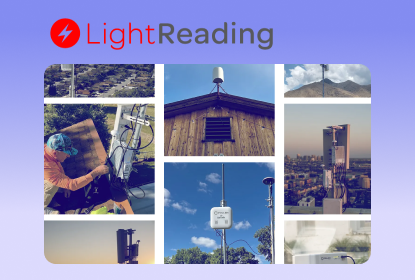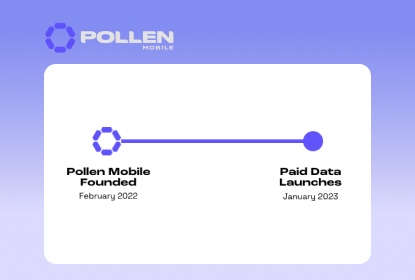Members from the Pollen Mobile team spent time in the North Hall’s IoT Wireless section and were inspired by what we saw and who we met. We visited booths, such as Blues Wireless, who shared their solutions for connecting customers’ devices to the cloud. We learned that Delta Air Lines and T-Mobile are teaming to provide free WiFi on their flights, so we can enjoy connectivity in the high altitudes as we jet across the country. We also visited Emnify, which is working on the Emnify SuperNetwork to deliver carrier-agnostic, multi-network coverage that enables IoT device deployment anywhere in the world.
It was energizing to speak with companies in our space working to supply connectivity in unique ways.
2023 will be a big year for Pollen and how we will deliver connectivity. In this blog, we outline two key ways that Pollen is advancing mobile connectivity.
Closing the Digital Divide
The digital divide has persisted and plagued largely low-income communities, in and out of cities, because legacy connectivity providers are too expensive, there is a lack of up-to-date technology, and there is often limited access to the internet and computers for the people in those communities.
According to the Pew Research Center, about four-in-ten adults with lower incomes, $30,000/year for a single person, do not have home broadband services.
At Pollen, we are focused on closing this gap. Pollen enables cities with historically underserved communities to build and easily create their own private networks. By doing so, we can deliver affordable connectivity solutions for homes, places of business, or community spaces.
For example, Shreveport, Louisiana, turned to Pollen to deliver affordable, reliable mobile connectivity in low-income neighborhoods where there was none. Legacy providers do not invest resources in these areas, preventing residents from accessing mobility where they need it most.
The city’s public library system installed Pollen’s equipment at five branch locations and provided residents with the tools they needed to access the Pollen network in their homes. Today, over 1,000 homes in Shreveport now have coverage powered by Pollen. Read more here.
Coverage Exactly Where You Need It
Pop Ups
One of our advantages is that the Pollen network is owned and operated by the community. Our users, whether small, medium, or large businesses — or everyday people — can deploy Pollen exactly where it is needed, indoors or outdoors. From remote farmlands to your favorite corner cafe, you can create your own wireless coverage.
In Los Angeles, a Pollen Mobile customer hosted an outdoor festival in a temporary venue with over 1,000 attendees. The year prior, event organizers reported that their existing mobile network was overburdened, disconnecting vendor Point of Sale Systems, which created sales losses and frustrated attendees. To prevent the same issues, the organizers deployed Pollen Mobile and successfully delivered reliable mobile connectivity — at a fraction of the cost — enabling higher volume sales and increasing attendee satisfaction. Read more here.
Industrial Sites
At a quarry in Santa Rosa, Pronto autonomous haulage vehicles have been deployed at their quarry to advance safety, efficiency and productivity. By using autonomous vehicles, industrial sites like mines, quarries and ports can solve for labor shortages and vehicle repairs and minimize accidents.
Mining sites that use autonomous haulage systems must also have mobile connectivity, no matter how remote their operations are. Pollen was developed out of this exact need. Pollen utilizes open-source mobile technologies that enable users to deploy wireless LTE networks at remote industrial locations, like ports and quarries, for a fraction of the cost. Mines may not have needed wireless connectivity a few years ago, but they sure do now, and Pollen is making that possible. Learn more about Pronto here.

Closing Thoughts
Pollen allows anyone to create private, affordable connectivity where they need it without jumping through hoops and accepting jaw-dropping carrier bills.
At CES, we met Pollen community members and our peers in the world of mobile connectivity. We all share a hope for the year ahead that focuses on better connectivity worldwide. Pollen will work for more awareness about more affordable alternatives to large telecom companies and ensure these options work, and in most cases…work better.
Ultimately, we predict that Pollen will be powering many sectors of IoT. We look forward to attending CES again in 2024 to showcase Pollen’s growth and to understand what work is left to do.



.png)











